A Bibliometric Analysis of the Impact of Ecological Restoration on Carbon Sequestration in Ecosystems
Abstract
1. Introduction
2. Materials and Methods
2.1. Materials
2.2. Methods
3. Results and Discussion
3.1. Research Force Analysis
3.1.1. National and Regional Analysis
3.1.2. Analysis of Research Institutions
3.1.3. Analysis of the Number of Posts
3.2. Analysis of Research Hotspots
3.3. Research Frontier Analysis
4. Conclusions
- (1)
- Through our analysis of the research output data, we found that China far surpasses other countries in terms of article production on the impact of ecological restoration on the carbon pool of ecosystems. In fact, China occupies six out of the top ten institutions in terms of publication output, with the top three institutions being the Chinese Academy of Sciences, the University of Chinese Academy of Sciences, and Northwest A&F University, in order. The close collaboration between these institutions reflects China’s important position in research on the impact of ecological restoration on the carbon pool function of ecosystems.
- (2)
- Based on the growth rate of the literature, the study on the impact of ecological restoration on ecosystem carbon storage can be roughly divided into three stages: the budding stage (1996–2009), the initial exploration stage (2009–2016), and the rapid development stage (2016 to present). The goodness of fit of the annual publication curve has reached 98%, indicating that the impact of ecological restoration on ecosystem carbon storage is still a hot research topic internationally. In the future, research on the impact of ecological restoration on ecosystem carbon storage will continue to rapidly develop, and new research theories, methods, and scientific and technological advancements will continue to emerge. Meanwhile, researchers in related fields will continue to track and study this topic for reference.
- (3)
- The current research hotspot in “the impact of ecological restoration on the carbon pool of ecosystems” mainly revolves around four divergent themes: “the carbon sequestration potential of ecological restoration”, “the technical approaches to enhancing the carbon sequestration function of ecological restoration in ecosystems”, “assessment methods for land-based carbon sinks,” and “characteristics of land-based carbon sources/sinks”. These themes are predominantly explored through collaborative research between different countries and exhibit a high degree of cross-disciplinary integration.
- (4)
- Currently, researchers are focusing on several key aspects related to the impact of ecological restoration on carbon storage in ecosystems, including soil nutrient, bacterial community, water-use efficiency, spatial distribution, ecological restoration projects, and land degradation. The longest studied keywords are related to fire and dissolved organic carbon (DOC).
- (1)
- Future research directions on the impact of ecological restoration on ecosystem carbon storage should focus on strengthening the study of the response mechanisms of ecological restoration under different landforms, climates, and vegetation types. Additionally, it is essential to combine factors of current global environmental change and maintain the continuity of research and observation on the impact of ecological restoration on ecosystem carbon storage to provide robust data support.
- (2)
- International cooperation and communication should be strengthened to establish a global network for ecological restoration research in order to explore the response mechanisms of different ecosystem carbon pools to ecological restoration on a global scale.
Author Contributions
Funding
Data Availability Statement
Conflicts of Interest
References
- Devoto, M.; Bailey, S.; Craze, P.; Memmott, J. Understanding and planning ecological restoration of plant-pollinator networks. Ecol. Lett. 2012, 15, 319–328. [Google Scholar] [CrossRef] [PubMed]
- Balaguer, L.; Escudero, A.; Martín-Duque, J.F.; Mola, I.; Aronson, J. The historical reference in restoration ecology: Re-defining a cornerstone concept. Biol. Conserv. 2014, 176, 12–20. [Google Scholar] [CrossRef]
- Lu, F.; Hu, H.; Sun, W.; Zhu, J.; Liu, G.; Zhou, W.; Zhang, Q.; Shi, P.; Liu, X.; Wu, X.; et al. Effects of national ecological restoration projects on carbon sequestration in China from 2001 to 2010. Proc. Natl. Acad. Sci. USA 2018, 115, 4039–4044. [Google Scholar] [CrossRef] [PubMed]
- Speldewinde, P.C.; Slaney, D.; Weinstein, P. Is restoring an ecosystem good for your health? Sci. Total Environ. 2015, 502, 276–279. [Google Scholar] [CrossRef] [PubMed]
- Abbas, S.; Nichol, J.E.; Fischer, G.A. A 70-year perspective on tropical forest regeneration. Sci. Total Environ. 2016, 544, 544–552. [Google Scholar] [CrossRef]
- Beddoe, R.; Costanza, R.; Farley, J.; Garza, E.; Kent, J.; Kubiszewski, I.; Martinez, L.; McCowen, T.; Murphy, K.; Myers, N.; et al. Overcoming systemic roadblocks to sustainability: The evolutionary redesign of worldviews, institutions, and technologies. Proc. Natl. Acad. Sci. USA 2009, 106, 2483–2489. [Google Scholar] [CrossRef]
- Lu, M.; Zhou, X.; Yang, Q.; Li, H.; Luo, Y.; Fang, C.; Chen, J.; Yang, X.; Li, B. Responses of ecosystem carbon cycle to experimental warming: A meta-analysis. Ecology 2013, 94, 726–738. [Google Scholar] [CrossRef]
- Ravindranath, N.H.; Ostwald, M. Carbon Inventory Methods: Handbook for Greenhouse Gas Inventory, Carbon Mitigation and Roundwood Production Projects; Springer Science & Business Media: Berlin/Heidelberg, Germany, 2007. [Google Scholar]
- Keenan, T.F.; Prentice, I.C.; Canadell, J.G.; A Williams, C.; Wang, H.; Raupach, M.; Collatz, G.J. Recent pause in the growth rate of atmospheric CO2 due to enhanced terrestrial carbon uptake. Nat. Commun. 2016, 7, 13428. [Google Scholar] [CrossRef]
- Pan, Y.; Birdsey, R.A.; Fang, J.; Houghton, R.; Kauppi, P.E.; Kurz, W.A.; Phillips, O.L.; Shvidenko, A.; Lewis, S.L.; Canadell, J.G.; et al. A Large and Persistent Carbon Sink in the World’s Forests. Science 2011, 333, 988–993. [Google Scholar] [CrossRef]
- Boisvenue, C.; Bergeron, Y.; Bernier, P.; Peng, C. Simulations show potential for reduced emissions and carbon stocks increase in boreal forests under ecosystem management. Carbon Manag. 2012, 3, 553–568. [Google Scholar] [CrossRef]
- Akin, M.; Eyduran, S.P.; Krauter, V. Food packaging related research trends in the academic discipline of food science and technology: A bibliometric analysis. Clean. Circ. Bioeconomy 2023, 5, 100046. [Google Scholar] [CrossRef]
- Chen, C.; Chen, Y.; Hou, J.; Liang, Y. CiteSpace II: Detecting and Visualizing Emerging Trends and Transient Patterns in Scientific Literature. J. China Soc. Sci. Technol. Inf. 2009, 28, 401–421. [Google Scholar]
- Liu, J.G.; Diamond, J. China’s environment in a globalizing world. Nature 2005, 435, 1179–1186. [Google Scholar] [CrossRef]
- Yin, R.S. Assessing China’s Ecological Restoration Programs. Environ. Manag. 2010, 45, 425–428. [Google Scholar] [CrossRef]
- Liu, J.; Li, S.; Ouyang, Z.; Tam, C.; Chen, X. Ecological and socioeconomic effects of China’s policies for ecosystem services. Proc. Natl. Acad. Sci. USA 2008, 105, 9477–9482. [Google Scholar] [CrossRef]
- Wang, G.Y.; Innes, J.L.; Lei, J.F.; Dai, S.Y.; Wu, S.W. Ecology—China’s forestry reforms. Science 2007, 318, 1556–1557. [Google Scholar] [CrossRef]
- Olawumi, T.O.; Chan DW, M. A scientometric review of global research on sustainability and sustainable development. J. Clean Prod. 2018, 183, 231–250. [Google Scholar] [CrossRef]
- Yang, G.; Nian-Peng, H.; Ya-Feng, W. Characteristics of Carbon Sequestration by Ecosystem and Progress in Its Research. J. Nat. Resour. 2013, 28, 1264–1274. [Google Scholar]
- Lal, R. Carbon sequestration. Philos. Trans. R. Soc. Biol. Sci. 2008, 363, 815–830. [Google Scholar] [CrossRef]
- Bossio, D.A.; Cook-Patton, S.C.; Ellis, P.W.; Fargione, J.; Sanderman, J.; Smith, P.; Wood, S.; Zomer, R.J.; von Unger, M.; Emmer, I.M.; et al. The role of soil carbon in natural climate solutions. Nat. Sustain. 2020, 3, 391–398. [Google Scholar] [CrossRef]
- Paul, K.; Polglase, P.; Nyakuengama, J.; Khanna, P. Change in soil carbon following afforestation. For. Ecol. Manag. 2002, 168, 241–257. [Google Scholar] [CrossRef]
- Eggleston, H.; Buendia, L.; Miwa, K.; Ngara, T.; Tanabe, K. 2006 IPCC Guidelines for National Greenhouse Gas Inventories; IPCC: Geneva, Switzerland, 2006. [Google Scholar]
- Hu, P.; Zhang, W.; Chen, H.; Li, D.; Zhao, Y.; Zhao, J.; Xiao, J.; Wu, F.; He, X.; Luo, Y.; et al. Soil carbon accumulation with increasing temperature under both managed and natural vegetation restoration in calcareous soils. Sci. Total. Environ. 2021, 767, 145298. [Google Scholar] [CrossRef] [PubMed]
- Deng, L.; Wang, K.; Zhu, G.; Liu, Y.; Chen, L.; Shangguan, Z. Changes of soil carbon in five land use stages following 10 years of vegetation succession on the Loess Plateau, China. Catena 2018, 171, 185–192. [Google Scholar] [CrossRef]
- Sun, L.P.; He, L.R.; Wang, G.L.; Jing, H.; Liu, G.B. Natural vegetation restoration of Liaodong oak forests rapidly increased the content and ratio of inert carbon in soil macroaggregates. J. Arid Land 2019, 11, 928–938. [Google Scholar] [CrossRef]
- Cai, W.; He, N.; Li, M.; Xu, L.; Wang, L.; Zhu, J.; Zeng, N.; Yan, P.; Si, G.; Zhang, X.; et al. Carbon sequestration of Chinese forests from 2010 to 2060: Spatiotemporal dynamics and its regulatory strategies. Sci. Bull. 2022, 67, 836–843. [Google Scholar] [CrossRef]
- Zanini, A.M.; Mayrinck, R.C.; Vieira, S.A.; De Camargo, P.B.; Rodrigues, R.R. The effect of ecological restoration methods on carbon stocks in the Brazilian Atlantic Forest. For. Ecol. Manag. 2021, 481, 11. [Google Scholar] [CrossRef]
- Bruce, J.P.; Frome, M.; Haites, E.; Janzen, H.; Lal, R.; Paustian, K. Carbon sequestration in soils. J. Soil Water Conserv. 1999, 54, 382–389. [Google Scholar]
- IPCC. Climate Change 2007: The Physical Science Basis; IPCC: Geneva, Switzerland, 2007. [Google Scholar]
- Food and Agriculture Organization of the United Nations. Global Forest Resources Assessment 2010: Main Report; Food and Agriculture Organization of the United Nations: Rome, Italy, 2010. [Google Scholar]
- Dixon, R.K.; Solomon, A.M.; Brown, S.; Houghton, R.; Trexier, M.; Wisniewski, J. Carbon Pools and Flux of Global Forest EcoSystems. Science 1994, 263, 185–190. [Google Scholar] [CrossRef]
- Kindermann, G.; McCallum, I.; Fritz, S.; Obersteiner, M. A global forest growing stock, biomass and carbon map based on FAO statistics. Silva Fenn. 2008, 42, 387–396. [Google Scholar] [CrossRef]
- Fang, J.; Yu, G.; Liu, L.; Hu, S.; Chapin, F.S., III. Climate change, human impacts, and carbon sequestration in China. Proc. Natl. Acad. Sci. USA 2018, 115, 4015–4020. [Google Scholar] [CrossRef]
- Pugh, T.A.M.; Lindeskog, M.; Smith, B.; Poulter, B.; Arneth, A.; Haverd, V.; Calle, L. Role of forest regrowth in global carbon sink dynamics. Proc. Natl. Acad. Sci. USA 2019, 116, 4382–4387. [Google Scholar] [CrossRef]
- Saatchi, S.S.; Harris, N.L.; Brown, S.; Lefsky, M.; Mitchard, E.T.A.; Salas, W.; Zutta, B.R.; Buermann, W.; Lewis, S.L.; Hagen, S.; et al. Benchmark map of forest carbon stocks in tropical regions across three continents. Proc. Natl. Acad. Sci. USA 2011, 108, 9899–9904. [Google Scholar] [CrossRef]
- Xiao, J.F.; Davis, K.J.; Urban, N.M.; Keller, K. Uncertainty in model parameters and regional carbon fluxes: A model-data fusion approach. Agric. For. Meteorol. 2014, 189, 175–186. [Google Scholar] [CrossRef]
- Running, S.W.; Nemani, R.R.; Heinsch, F.A.; Zhao, M.S.; Reeves, M.; Hashimoto, H. A continuous satellite-derived measure of global terrestrial primary production. Bioscience 2004, 54, 547–560. [Google Scholar] [CrossRef]
- Goetz, S.; Dubayah, R. Advances in remote sensing technology and implications for measuring and monitoring forest carbon stocks and change. Carbon Manag. 2011, 2, 231–244. [Google Scholar] [CrossRef]
- Ni, J. Carbon storage in Chinese terrestrial ecosystems: Approaching a more accurate estimate. Clim. Chang. 2013, 119, 905–917. [Google Scholar] [CrossRef]
- Broecker, W.S.; Takahashi, T.; Simpson, H.J.; Peng, T.-H. Fate of Fossil Fuel Carbon Dioxide and the Global Carbon Budget. Science 1979, 206, 409–418. [Google Scholar] [CrossRef]
- Reiners, W.A. Terrestrial detritus and the carbon cycle. Brookhaven Symp. Biol. 1973, 24, 303–327. [Google Scholar]
- Tans, P.P.; Fung, I.Y.; Takahashi, T. Observational Contrains on the Global Atmospheric CO2 Budget. Science 1990, 247, 1431–1438. [Google Scholar] [CrossRef]
- Friedlingstein, P.; O’sullivan, M.; Jones, M.W.; Andrew, R.M.; Hauck, J.; Olsen, A.; Peters, G.P.; Peters, W.; Pongratz, J.; Sitch, S.; et al. Global carbon budget 2020. Earth Syst. Sci. Data 2020, 12, 3269–3340. [Google Scholar] [CrossRef]
- Tian, H.; Chen, G.; Zhang, C.; Liu, M.; Sun, G.; Chappelka, A.; Ren, W.; Xu, X.; Lu, C.; Pan, S.; et al. Century-Scale Responses of Ecosystem Carbon Storage and Flux to Multiple Environmental Changes in the Southern United States. Ecosystems 2012, 15, 674–694. [Google Scholar] [CrossRef]
- Feng, X.; Fu, B.; Piao, S.; Wang, S.; Ciais, P.; Zeng, Z.; Lü, Y.; Zeng, Y.; Li, Y.; Jiang, X.; et al. Revegetation in China’s Loess Plateau is approaching sustainable water resource limits. Nat. Clim. Chang. 2016, 6, 1019–1022. [Google Scholar] [CrossRef]
- Fu, B.; Wang, S.; Liu, Y.; Liu, J.; Liang, W.; Miao, C. Hydrogeomorphic Ecosystem Responses to Natural and Anthropogenic Changes in the Loess Plateau of China. Annu. Rev. Earth Planet. Sci. 2017, 45, 223–243. [Google Scholar] [CrossRef]
- Fu, B.; Liu, Y.; Lü, Y.; He, C.; Zeng, Y.; Wu, B. Assessing the soil erosion control service of ecosystems change in the Loess Plateau of China. Ecol. Complex. 2011, 8, 284–293. [Google Scholar] [CrossRef]
- An, S.-S.; Darboux, F.; Cheng, M. Revegetation as an efficient means of increasing soil aggregate stability on the Loess Plateau (China). Geoderma 2013, 209–210, 75–85. [Google Scholar] [CrossRef]
- Feng, X.; Fu, B.; Lu, N.; Zeng, Y.; Wu, B. How ecological restoration alters ecosystem services: An analysis of carbon sequestration in China’s Loess Plateau. Sci. Rep. 2013, 3, 2846. [Google Scholar] [CrossRef]
- Deng, L.; Shangguan, Z.-P.; Wu, G.-L.; Chang, X.-F. Effects of grazing exclusion on carbon sequestration in China’s grassland. Earth-Sci. Rev. 2017, 173, 84–95. [Google Scholar] [CrossRef]
- Shackelford, N.; Hobbs, R.J.; Burgar, J.M.; Erickson, T.E.; Fontaine, J.B.; Laliberté, E.; Ramalho, C.E.; Perring, M.P.; Standish, R.J. Primed for Change: Developing Ecological Restoration for the 21st Century. Restor. Ecol. 2013, 21, 297–304. [Google Scholar] [CrossRef]
- Li, X.; Wu, P.; Shen GQ, P.; Wang, X.Y.; Teng, Y. Mapping the knowledge domains of Building Information Modeling (BIM): A bibliometric approach. Autom. Constr. 2017, 84, 195–206. [Google Scholar] [CrossRef]
- Pollack, J.; Adler, D. Emergent trends and passing fads in project management research: A scientometric analysis of changes in the field. Int. J. Proj. Manag. 2015, 33, 236–248. [Google Scholar] [CrossRef]
- González, M.E. Fire history data as reference information in ecological restoration. Dendrochronologia 2005, 22, 149–154. [Google Scholar] [CrossRef]
- Kauffman, J.B. Death Rides the Forest: Perceptions of Fire, Land Use, and Ecological Restoration of Western Forests. Conserv. Biol. 2004, 18, 878–882. [Google Scholar] [CrossRef]
- Rocca, M.E.; Miniat, C.F.; Mitchell, R.J. Introduction to the regional assessments: Climate change, wildfire, and forest ecosystem services in the USA. For. Ecol. Manag. 2014, 327, 265–268. [Google Scholar] [CrossRef]
- Wang, C.; Wang, G.; Wang, Y.; Rafique, R.; Ma, L.; Hu, L.; Luo, Y. Fire Alters Vegetation and Soil Microbial Community in Alpine Meadow. Land Degrad. Dev. 2016, 27, 1379–1390. [Google Scholar] [CrossRef]
- Yoder, J.; Engle, D.; Fuhlendorf, S. Liability, incentives, and prescribed fire for ecosystem management. Front. Ecol. Environ. 2004, 2, 361–366. [Google Scholar] [CrossRef]
- Arístegui, J.; Duarte, C.M.; Agustí, S.; Doval, M.; AÁlvarez-Salgado, X.A.; Hansell, D.A. Dissolved Organic Carbon Support of Respiration in the Dark Ocean. Science 2002, 298, 1967. [Google Scholar] [CrossRef]
- Ludwig, W.; Probst, J.L.; Kempe, S. Predicting the oceanic input of organic carbon by continental erosion. Glob. Biogeochem. Cycle 1996, 10, 23–41. [Google Scholar] [CrossRef]
- Meybeck, M. Carbon, nitrogen, and phosphorus transport by world rivers. Am. J. Sci. 1982, 282, 401–450. [Google Scholar] [CrossRef]
- Fakhraee, M.; Tarhan, L.G.; Planavsky, N.J.; Reinhard, C.T. A largely invariant marine dissolved organic carbon reservoir across Earth’s history. Proc. Natl. Acad. Sci. USA 2021, 118, 6. [Google Scholar] [CrossRef]
- Farjalla, V.F.; Azevedo, D.A.; Esteves, F.A.; Bozelli, R.L.; Roland, F.; Enrich-Prast, A. Influence of Hydrological Pulse on Bacterial Growth and DOC Uptake in a Clear-Water Amazonian Lake. Microb. Ecol. 2006, 52, 334–344. [Google Scholar] [CrossRef]
- Baines, S.B.; Pace, M.L. The production of dissolved organic matter by phytoplankton and its importance to bacteria: Patterns across marine and freshwater systems. Limnol. Oceanogr. 1991, 36, 1078–10900. [Google Scholar] [CrossRef]
- Kruger, B.R.; Werne, J.P.; Branstrator, D.K.; Hrabik, T.R.; Chikaraishi, Y.; Ohkouchi, N.; Minor, E.C. Organic matter transfer in L ake S uperior’s food web: Insights from bulk and molecular stable isotope and radiocarbon analyses. Limnol. Oceanogr. 2016, 61, 149–164. [Google Scholar] [CrossRef]
- Hu, A.; Choi, M.; Tanentzap, A.J.; Liu, J.; Jang, K.-S.; Lennon, J.T.; Liu, Y.; Soininen, J.; Lu, X.; Zhang, Y.; et al. Ecological networks of dissolved organic matter and microorganisms under global change. Nat. Commun. 2022, 13, 3600. [Google Scholar] [CrossRef]
- Liu, D.; Yu, S.J.; Duan, H.T. Different storm responses of organic carbon transported to Lake Taihu by the eutrophic Tiaoxi River, China. Sci. Total Environ. 2021, 782, 11. [Google Scholar] [CrossRef] [PubMed]
- Liu, D.; Yu, S.J.; Xiao, Q.T.; Qi, T.C.; Duan, H.T. Satellite estimation of dissolved organic carbon in eutrophic Lake Taihu, China. Remote Sens. Environ. 2021, 264, 14. [Google Scholar] [CrossRef]
- Han, M.; Zhao, Q.; Li, W.; Ciais, P.; Wang, Y.; Goll, D.S.; Zhu, L.; Zhao, Z.; Wang, J.; Wei, Y.; et al. Global soil organic carbon changes and economic revenues with biochar application. GCB Bioenergy 2022, 14, 364–377. [Google Scholar] [CrossRef]
- Mu, C.; Abbott, B.W.; Norris, A.J.; Mu, M.; Fan, C.; Chen, X.; Jia, L.; Yang, R.; Zhang, T.; Wang, K.; et al. The status and stability of permafrost carbon on the Tibetan Plateau. Earth-Sci. Rev. 2020, 211, 103433. [Google Scholar] [CrossRef]
- Niemi, R.M.; Heiskanen, I.; Wallenius, K.; Lindstrom, K. Extraction and purification of DNA in rhizosphere soil samples for PCR-DGGE analysis of bacterial consortia. J. Microbiol. Methods 2001, 45, 155–165. [Google Scholar] [CrossRef]
- Han, Y.; Wen-Hui, Y.; Wang, W.; Wang, Y.; Wang, H. Soil bacteria diversity in continuous cropping poplar plantation by high throughput sequencing. J. Shandong Univ. 2014, 49, 1–6. [Google Scholar]
- Jansson, J.K.; Hofmockel, K.S. Soil microbiomes and climate change. Nat. Rev. Microbiol. 2020, 18, 35–46. [Google Scholar] [CrossRef]
- Bastida, F.; Eldridge, D.J.; García, C.; Png, G.K.; Bardgett, R.D.; Delgado-Baquerizo, M. Soil microbial diversity–biomass relationships are driven by soil carbon content across global biomes. ISME J. 2021, 15, 2081–2091. [Google Scholar] [CrossRef]
- Liang, C.; Schimel, J.P.; Jastrow, J.D. The importance of anabolism in microbial control over soil carbon storage. Nat. Microbiol. 2017, 2, 6. [Google Scholar] [CrossRef]
- Sokol, N.W.; Sanderman, J.; Bradford, M.A. Pathways of mineral-associated soil organic matter formation: Integrating the role of plant carbon source, chemistry, and point of entry. Glob. Chang. Biol. 2019, 25, 12–24. [Google Scholar] [CrossRef]
- Yu, C.; Li, Y.; Mo, R.; Deng, W.; Zhu, Z.; Liu, D.; Hu, X. Effects of long-term straw retention on soil microorganisms under a rice-wheat cropping system. Arch. Microbiol. 2020, 202, 1915–1927. [Google Scholar] [CrossRef]
- Ding, Z.; Liu, Y.; Wang, L.; Chen, Y.; Yu, P.; Ma, M.; Tang, X. Effects and implications of ecological restoration projects on ecosystem water use efficiency in the karst region of Southwest China. Ecol. Eng. 2021, 170, 9. [Google Scholar] [CrossRef]
- Shimamoto, C.Y.; Padial, A.A.; da Rosa, C.M.; Marques, M.C.M. Restoration of ecosystem services in tropical forests: A global meta-analysis. PLoS ONE 2018, 13, e0208523. [Google Scholar] [CrossRef]
- Li, W.; Wang, J.L.; Zhang, X.J.; Shi, S.L.; Cao, W.X. Effect of degradation and rebuilding of artificial grasslands on soil respiration and carbon and nitrogen pools on an alpine meadow of the Qinghai-Tibetan Plateau. Ecol. Eng. 2018, 111, 134–142. [Google Scholar] [CrossRef]
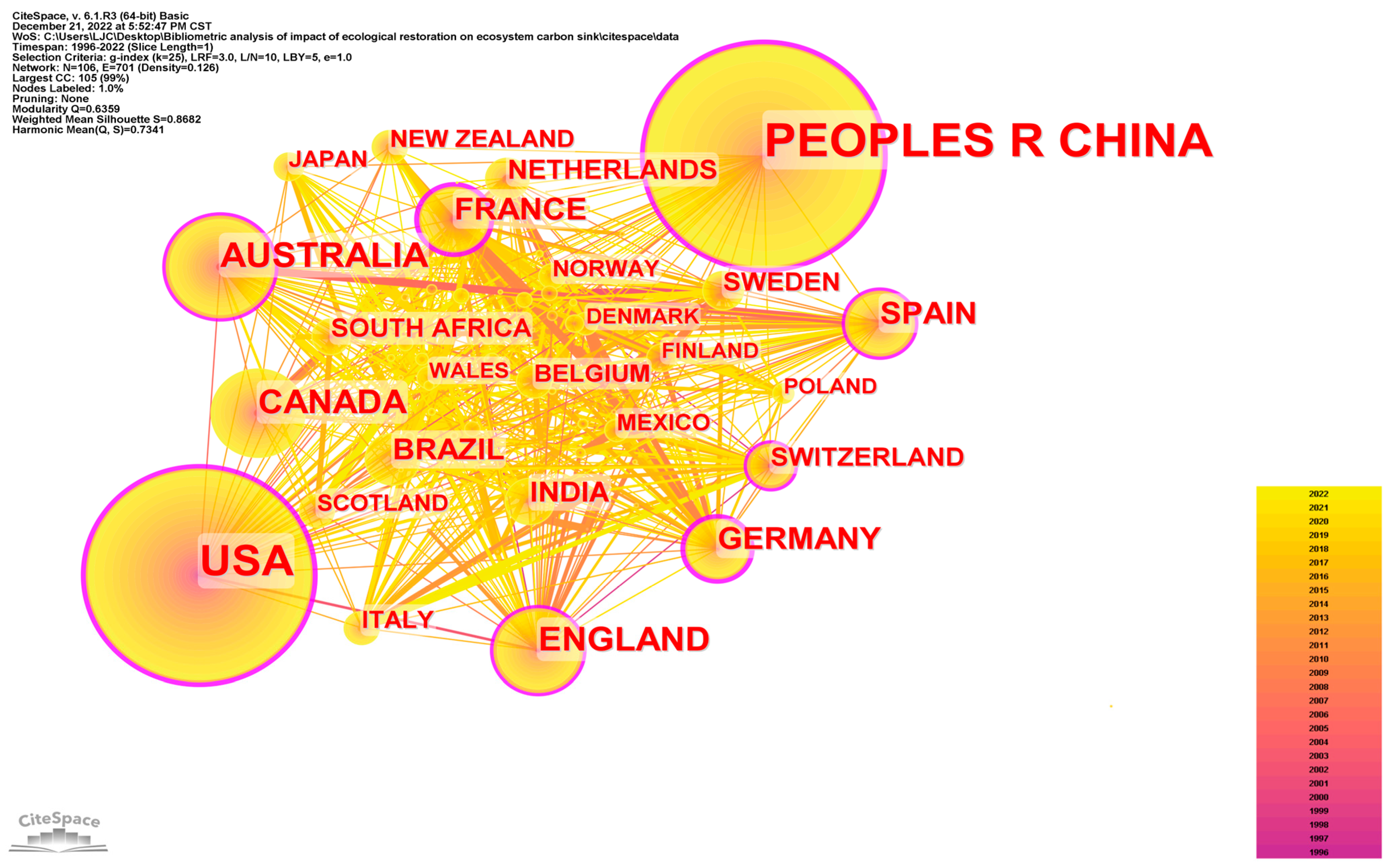
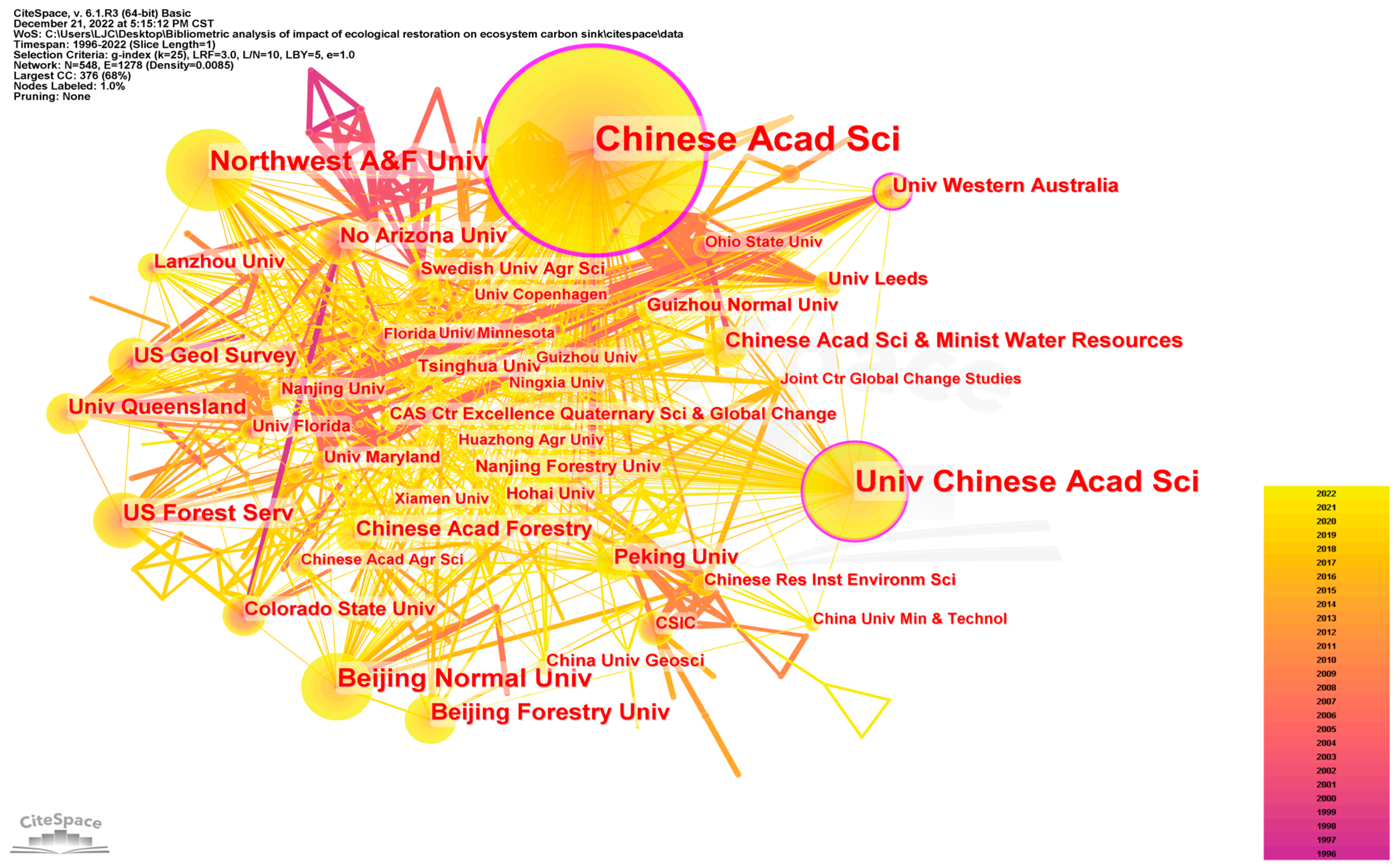

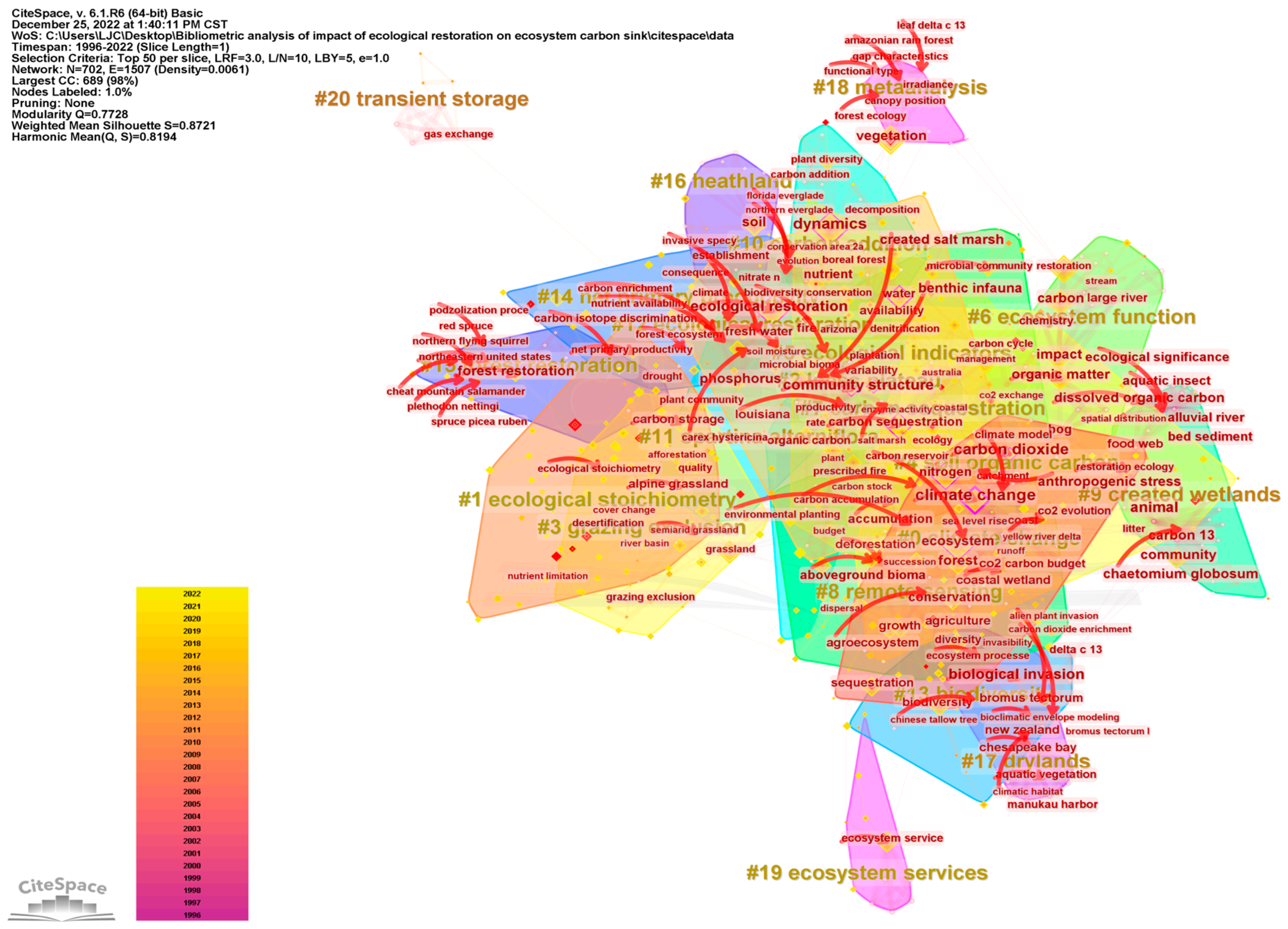
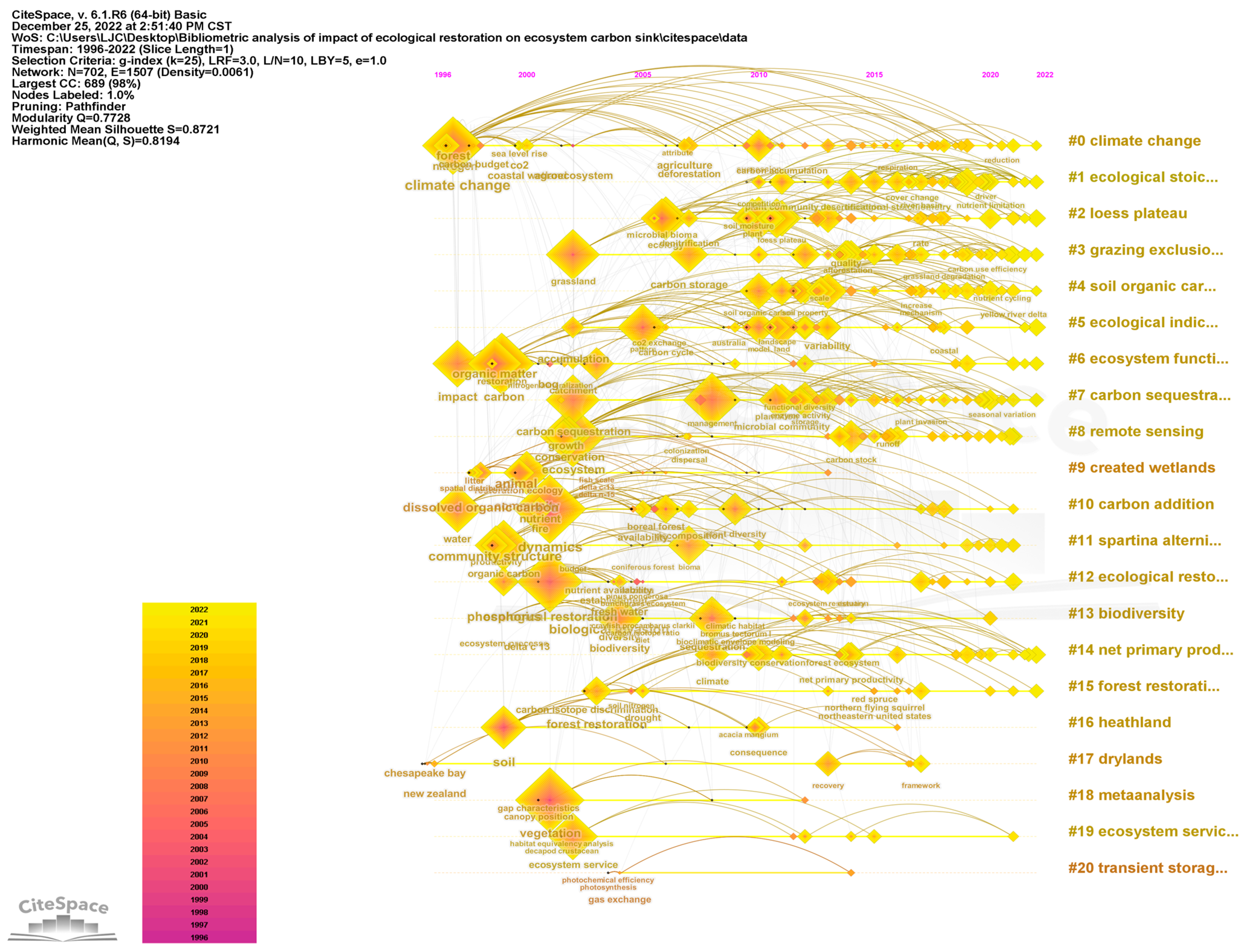
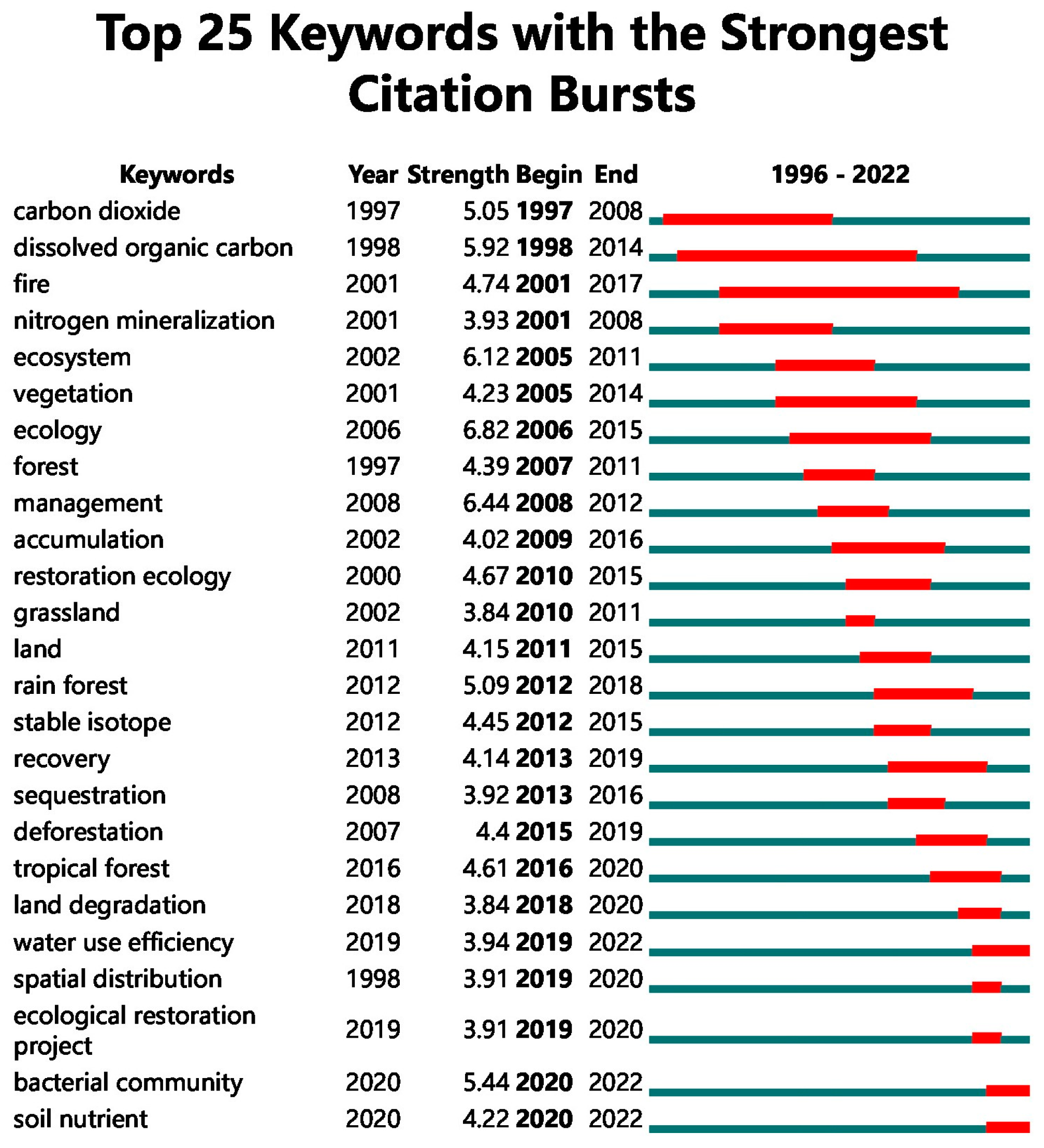
| Ranking | Country | Article Quantities | Betweenness Centrality |
|---|---|---|---|
| 1 | China | 735 | 0.2 |
| 2 | USA | 439 | 0.26 |
| 3 | Australia | 133 | 0.14 |
| 4 | England | 101 | 0.19 |
| 5 | Canada | 91 | 0.05 |
| 6 | Germany | 70 | 0.22 |
| 7 | Spain | 63 | 0.18 |
| 8 | France | 61 | 0.25 |
| 9 | Brazil | 56 | 0.01 |
| 10 | India | 47 | 0.01 |
| Ranking | Institution | Article Quantities | Betweenness Centrality |
|---|---|---|---|
| 1 | Chinese Acad Sci | 299 | 0.47 |
| 2 | Univ Chinese Acad Sci | 131 | 0.13 |
| 3 | Northwest A&F Univ | 85 | 0.06 |
| 4 | Beijing Normal Univ | 64 | 0.04 |
| 5 | Beijing Forestry Univ | 35 | 0.01 |
| 6 | US Forest Serv | 34 | 0.08 |
| 7 | Chinese Acad Forestry | 27 | 0.05 |
| 8 | Univ Queensland | 26 | 0.08 |
| 9 | Northern Arizona Univ | 26 | 0.03 |
| 10 | US Geol Survey | 24 | 0.03 |
| Cluster Number | Cluster Name | Cluster Size | Silhouette | Mean Year | Cluster Label (LLR) |
|---|---|---|---|---|---|
| 0 | Climate change | 66 | 0.907 | 2007 | Climate change; sea-level rise; temperature; carbon dioxide; soil enzymes |
| 1 | Ecological stoichiometry | 54 | 0.867 | 2018 | Ecological stoichiometry; scenario analysis; nutrient limitation; Tibetan Plateau; net primary production |
| 2 | Loess Plateau | 45 | 0.74 | 2013 | Loess Plateau; vegetation restoration; soil moisture; land use; nature-based solutions |
| 3 | Grazing exclusion | 43 | 0.795 | 2016 | Grazing exclusion; alpine meadow; grassland degradation; carbon storage; grazing |
| 4 | Soil organic carbon | 43 | 0.804 | 2016 | Soil organic carbon; soil aggregate; soil properties; soil microbial community; organic carbon fraction |
| 5 | Ecological indicators | 42 | 0.837 | 2012 | Ecological indicators; alternate stable states; spatial variability; trees; carbon cycle |
| 6 | Ecosystem function | 42 | 0.939 | 2005 | Ecosystem function; restoration; natural capital; biosolids; retention |
| 7 | Carbon sequestration | 42 | 0.795 | 2014 | Carbon sequestration; sustainable development; bacterial community; microbial communities; enzyme activities |
| 8 | Remote sensing | 41 | 0.856 | 2013 | Remote sensing; carbon stock; aboveground biomass; species richness; conservation |
| 9 | Created wetlands | 39 | 0.964 | 2000 | Created wetlands; restoration ecology; food webs; allelopathy; food web |
| 10 | Carbon addition | 36 | 0.886 | 2007 | Carbon addition; plant diversity; tallgrass prairie; tree islands; Florida |
| 11 | Spartina alterniflora | 29 | 0.897 | 2006 | Spartina alterniflora; community structure; water quality; organic carbon; rhizosphere fungi |
| 12 | Ecological restoration | 29 | 0.889 | 2009 | Ecological restoration; ecosystem restoration; stoichiometry; tree diversity; Paris agreement |
| 13 | Biodiversity | 27 | 0.97 | 2007 | Biodiversity; earthworms; soil fauna; bibliometric analysis; soil microbiome |
| 14 | Net primary productivity | 25 | 0.803 | 2015 | Net primary productivity; water use efficiency; casa model; human activities; ecological restoration |
| 15 | Forest restoration | 22 | 0.936 | 2012 | Forest restoration; environmental monitoring; secondary forest; red spruce; soil nitrogen |
| 16 | Heathland | 17 | 0.935 | 2006 | Heathland; termites; root nodule; zonation; Southern China |
| 17 | Drylands | 15 | 0.907 | 2002 | Drylands; phytoplankton biome; fluvial deposit; fish production; sentinels |
| 18 | Meta-analysis | 12 | 0.983 | 2003 | Meta-analysis; forest ecology; climate change; vegetation; restoration treatment |
| 19 | Ecosystem services | 11 | 0.963 | 2007 | Ecosystem services; valuation; ecosystem service; sediment; coastal management |
| 20 | Transient storage | 9 | 1 | 2007 | Transient storage; semi-arid sandland; quantum efficiency; sparse-elm grassland; stream daylighting |
Disclaimer/Publisher’s Note: The statements, opinions and data contained in all publications are solely those of the individual author(s) and contributor(s) and not of MDPI and/or the editor(s). MDPI and/or the editor(s) disclaim responsibility for any injury to people or property resulting from any ideas, methods, instructions or products referred to in the content. |
© 2023 by the authors. Licensee MDPI, Basel, Switzerland. This article is an open access article distributed under the terms and conditions of the Creative Commons Attribution (CC BY) license (https://creativecommons.org/licenses/by/4.0/).
Share and Cite
Liu, J.; Gao, W.; Liu, T.; Dai, L.; Wu, L.; Miao, H.; Yang, C. A Bibliometric Analysis of the Impact of Ecological Restoration on Carbon Sequestration in Ecosystems. Forests 2023, 14, 1442. https://doi.org/10.3390/f14071442
Liu J, Gao W, Liu T, Dai L, Wu L, Miao H, Yang C. A Bibliometric Analysis of the Impact of Ecological Restoration on Carbon Sequestration in Ecosystems. Forests. 2023; 14(7):1442. https://doi.org/10.3390/f14071442
Chicago/Turabian StyleLiu, Juncong, Weichang Gao, Taoze Liu, Liangyu Dai, Linjing Wu, Haiying Miao, and Cheng Yang. 2023. "A Bibliometric Analysis of the Impact of Ecological Restoration on Carbon Sequestration in Ecosystems" Forests 14, no. 7: 1442. https://doi.org/10.3390/f14071442
APA StyleLiu, J., Gao, W., Liu, T., Dai, L., Wu, L., Miao, H., & Yang, C. (2023). A Bibliometric Analysis of the Impact of Ecological Restoration on Carbon Sequestration in Ecosystems. Forests, 14(7), 1442. https://doi.org/10.3390/f14071442





